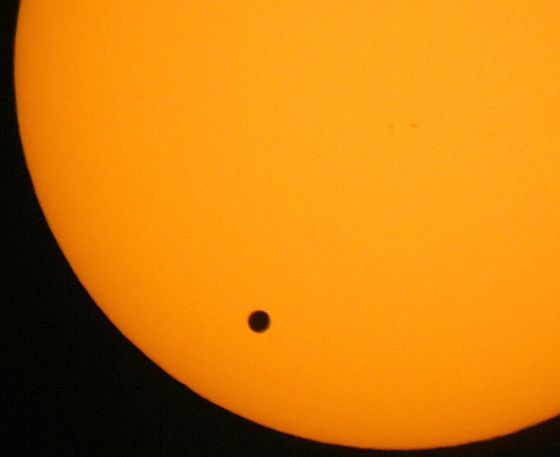
Look Now for Venus to Cross the Sun, or Wait Another Century
(From “The New York Times”, May 28, 2012)
“The next transit of Venus will occur next Tuesday, and will be visible,
at least for a while before sunset, across the United States. In New
York and along the East Coast, the Sun will be low in the sky, requiring
observers to find locations not be obscured by trees or buildings. (A
west-facing window up high in a skyscraper could be a good place to
watch.) The usual precautions about not looking directly at the Sun
apply. Special eclipse viewing glasses can be used, or the image of the
Sun can be projected through a pinhole or binoculars onto a sheet of
paper.
While no longer of great scientific import, as it was to Rittenhouse and
Captain Cook, a Venus transit is still a rare and striking event,
occurring in pairs, eight years apart, about once a century. The last
transit occurred in 2004, and almost no one alive today will be around
for the next one, 105 years from now, on Dec. 11, 2117.
(That one will not be visible at all from most of the United States.
New Yorkers, however, will have a prime viewing spot for the following
transit, on Dec. 8, 2125.)
It was only in 1627 that anyone realized Venus transits occurred at all.
That year, Johannes Kepler, the mathematician and astronomer, published
data about the planetary orbits that predicted that Venus would pass
directly between Earth and the Sun in 1631.
Kepler died in 1630, and it appears no one saw the 1631 transit. (It was
not visible from Europe.) The first recorded observation of a transit
was in 1638, which Kepler had not predicted. Jeremiah Horrocks, an
English astronomer, realized Kepler had made an error in his
calculations.
In 1716, Edmund Halley, the English astronomer remembered for the comet
named after him, proposed how a transit of Venus could be used to figure
out how far the Earth lay from the Sun.
At different locations on Earth, the path of Venus across the Sun would
shift slightly, as would the transit times. With precise measurements,
that would allow someone to triangulate the Sun’s position.
The first attempts came during the 1761 transit, but too few were
successful to calculate the distance. The 1769 effort was bigger and
wider.
In Pennsylvania, Rittenhouse, a noted instrument maker, mathematician,
astronomer and member of the American Philosophical Society, set up an
observatory on his farm to make the transit observations.
The society, the pre-eminent scientific organization in colonial
America, also set up observing stations in the yard next to the
Pennsylvania Statehouse — now Independence Hall — and along the shores
of what is now Delaware.
Rittenhouse’s detailed description of the transit, accompanied by an
exacting diagram, was published in the most prestigious scientific
journal of the time, The Philosophical Transactions, published by the
Royal Society in London.
“That really put these colonial scientists nobody had paid attention to
on the map,” said Sue Ann Prince, director and curator for the American
Philosophical Society’s museum.
The answer that came out of the worldwide 1769 observations was pretty
good: 95 million miles. (Actual answer: 93 million.) “Historically
speaking, it’s the beginning of big international science,” Dr.
Gingerich said.
More expeditions went out to observe the transits in 1874 and 1882, but
already the events were becoming more of a spectacle for the public.
John Philip Sousa wrote a march to celebrate.
With modern technology — radar, in particular — astronomers can now
measure solar system distances much more accurately than was possible
with the transit technique. But some scientists will be making careful
observations of this transit to help with understanding planets around
other stars.
Some of those planets have been discovered by the brief dimming of
starlight as they pass in front of the parent stars. By looking at the
particulars of how the colors change, that could even give clues of the
atmosphere of those distant, unseen planets”.